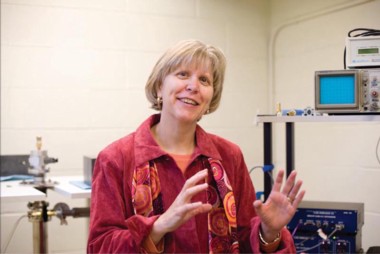“We Will Go to Other Planets”
Mount Holyoke College astronomy professor Darby Dyar has been named to three NASA teams that work on long-range plans to colonize the moon and land spaceships on Mars. Dyar’s threefold mission is to help develop methodology for analyzing extremely small samples of substances collected from other planets; to teach graduate students to use specialized equipment to discover, from a spacecraft in orbit, what minerals are present on a given planet; and to try to determine how much hydrogen exists on the moon, because the presence of hydrogen is an indicator of the potential availability of water there.
“I think that, in my lifetime, we will go to other planets and establish bases there,” Dyar said in a statement announcing the projects. Mount Holyoke will receive a NASA grant of nearly $1 million to support her work.
By the Numbers:
$29,400
That’s the average debt in 2012 carried by seniors graduating from college who had debt (71 percent, up from 68 percent in 2008). Since 2008, when it was estimated at $23,450, the amount of debt has grown by 6 percent a year, and has continued to rise in spite of the publicity the student loan crisis has received since it began receiving media attention in 2010.
Average debt by state varied in 2012 from $18,000 to $33,650; in Massachusetts it was $28,460, lower than the overall average. Neighboring New Hampshire was the second highest-debt state; its graduates carried an average load of $32,698. Rhode Island was fifth with $31,156. Debt for those attending public or nonprofit colleges averaged only slightly lower than the average: $27,850. This data is based on figures colleges report to the federal government and other sources on a voluntary basis, and tallied by The Institute for College Access and Success.
Domestic Violence Survey By the Numbers
96
The percentage of respondents to a survey by the Southern Hilltown Domestic Violence Task Force who agreed that it’s “possible to abuse someone without using physical violence”
66
The percentage who believed that other Hilltown residents would agree with that statement
85
The percentage who believe that “abuse is never the fault of the person being abused”
54
The percentage of respondents who thought others would agree with that statement
74
The percentage who knew at least one agency they could go to for help
The full survey results can be found on the Southern Hilltown Domestic Violence Task Force’s Facebook page. The task force plans to use the data in a new public education campaign.
Report Card from the Delivery Room
Valley hospitals racked up overall impressive scores in an analysis of childbirth-related practices put together by Boston public radio station WBUR.
The report evaluated hospitals across Massachusetts on five criteria: their rates of elective early deliveries (a practice criticized by many healthcare professionals), first-time Cesarean sections, vaginal births after C-sections (known as VBACs), episiotomies and exclusive breastfeeding by mothers while in the hospital.
While the World Health Organization calls for C-section rates of no more than 15 percent, the report notes, only two of the 47 hospitals surveyed met that standard, among them Baystate Franklin Medical Center. Baystate Franklin also had the highest rate of VBACs in the state (29.4 percent) as well as the lowest episiotomy rate (1.1 percent). (Data was not available from all hospitals for all five criteria.)
Northampton’s Cooley Dickinson Hospital had the highest exclusive breastfeeding rate in the state (93 percent). Holyoke Medical Center had the second-highest VBAC rate in the state (24 percent), a breastfeeding rate of 75 percent and a low episiotomy rate. Springfield’s Mercy Medical Center had a breastfeeding rate of 73 percent. Cooley Dickinson, Holyoke, Mercy and Baystate Franklin all reported no elective early deliveries, according to WBUR.
Baystate Medical Center in Springfield, which has the only neonatal intensive care unit in the Valley and sees a disproportionate number of high-risk cases, had a low breastfeeding rate (25 percent) but also a low episiotomy rate (4.2 percent) and relatively high VBAC rate of 12.4 percent.
The full report, plus an interactive hospital map, is online at commonhealth/wbur.org; search for “childbirth data.”
“The people who call Holyoke home can feel the sense of possibility in the air. You aren’t waiting for City Hall to act; you’re taking Holyoke’s future into your own hands. Those of us on this stage today must be prepared to take our direction from you. Where the city government can further empower our citizens, and bolster this homegrown renewal, it will; where the city government now impedes that renewal, it will get out of the way. We will let Holyoke make Holyoke again.”
Holyoke Mayor Alex Morse in his inaugural address last week



